Will buses ever be cool? Boston versus the Raleigh-Durham's GoTransit Model
 "Will buses ever be cool?" is the title of an article in the Boston Globe, which discusses the Better Buses campaign of Boston's Livable Streets Alliance, a sustainable mobility advocacy group. From the article:
"Will buses ever be cool?" is the title of an article in the Boston Globe, which discusses the Better Buses campaign of Boston's Livable Streets Alliance, a sustainable mobility advocacy group. From the article:Stacy Thompson wants buses to be cool. It might seem like a long shot, but she’s not alone.I have many posts on this topic, dating to 2005, and a too comprehensive post on this topic, "Making bus service sexy and more equitable," dating to 2012.
Public transportation advocates have long lobbied the Massachusetts Bay Transportation Authority for better bus service, with varied success. Now, they’re trying another approach: giving the humble bus an image makeover in hopes of boosting its popularity and, perhaps, its perceived status.
“Buses are not the second-class citizens of the transit system,” said Thompson, executive director of Livable Streets Alliance, a local transportation advocacy group. “They can be awesome, and they should be fun.”
The alliance launched a “Better Buses Week” initiative in the fall with a session called “Making Buses Sexy,” and the Barr Foundation in the coming weeks will encourage people to share photographs from buses in a social media campaign called “Beauty and the Bus.”
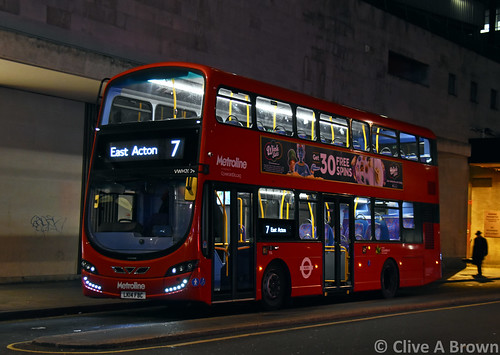 London bus, Flickr photo by Clive Brown.
London bus, Flickr photo by Clive Brown. The basic concept is to disruptively rebrand bus service by using a different kind of bus, complemented by a wide variety of other upgrades to the service and amenities package surrounding bus service.
Because of the popularity of the double deck bus in London, and throughout the UK, I figure the best way to do this is to shift to the double deck bus.
(In North America such buses are used by tourist transit services and a few transit agencies. Ottawa, Ontario has the largest fleet of double deck buses in traditional transit service.)
Later I suggested given anti-transit, I mean anti-streetcar people say we don't need streetcars, just better bus service, that we should truly test a high quality bus service, using double deck buses versus streetcar service, to see if making bus service great, which includes:
- double deck buses
- a great design scheme
- high quality shelters and stations
- great marketing and wayfinding information
- reliable and frequent enough service
- that is efficient in getting people to their destination
I like how the buses in the Brighton & Hove system are branded with the route of the bus.
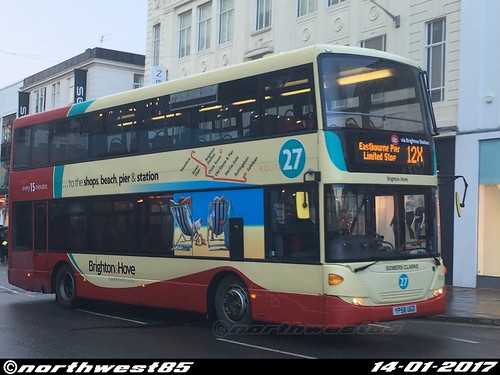
In DC, it would be relatively easy to shift to double deck buses, because for the most part, utility wires and traffic signal infrastructure doesn't go across the roads--except on side streets. Although there would be a problem accommodating such vehicles in bus garages.
It would be harder in the suburbs because their utility wire and traffic signal infrastructure is different.
Bus rapid transit positioning as the model. One of the ways bus rapid transit systems aim to reposition their service vis-a-vis traditional bus service is through design, design forward shelter and station infrastructure, marketing, wayfinding materials, and fast, frequent service.
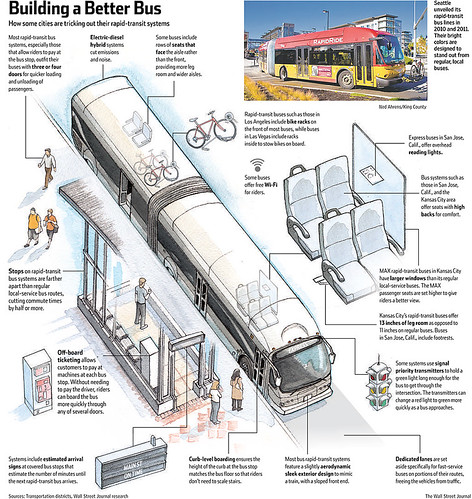
Wall Street Journal graphic.
But why should we limit such "amenities" to premium bus service?
In most places, traditional bus service, as a legacy system, is in dire need of a reboot.
Metroway bus stop, Arlington County, Virginia. Flickr photo by BeyondDC.
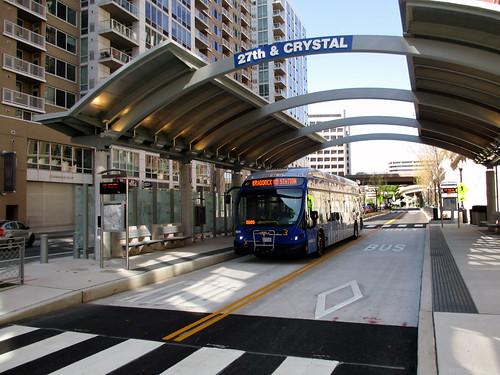
Raleigh-Durham and GoTransit. For years I have argued transit/transportation planning in the DC metropolitan area is sub-optimal, that we don't really plan at that scale, that by default WMATA (Metrorail and Metrobus) is the planner, and for the most part, network breadth and frequency of service is satisficed in favor of year-to-year vagaries of the annual budget.
-- "Metropolitan Mass Transit Planning presentation
-- "Route 7 BRT proposal communicates the reality that the DC area doesn't adequately conduct transportation planning at the metropolitan-scale"
In September, I came across an article about the rebanding of transit in Cary, North Carolina ("Cary's Buses Switching Names, Offering Free Rides," Cary Citizen) which clued me into the fact that this rebranding is part of a larger effort.
Across the Research Triangle region, the transit agencies there--Triangle Transit provides service across jurisdictions, while the major jurisdictions (Raleigh, Cary, Chapel Hill) each have intra-city transit services also--have been developing an integrated form of collaborative service delivery for over a decade.
So I sought out and interviewed David Eatman, the transit administrator for the City of Raleigh, who was kind enough to speak to me at length about the transit program there.
The level of transit service integration includes:
- coordinated schedules
- one single call center 485-RIDE (in DC, each transit agency has its own set up/phone number to provide information), as well as an integrated mobile product that includes information from all the transit agencies
- a common fare media product
- a regional transit pass charging one price for use of all or any of the transit services (the DC area does have a regional bus pass, but it is not well marketed; it's easier for Baltimore to do this because they do not have multiple agencies providing services and information, whereas in the DC area at least nine different agencies provide bus service)
- joint purchasing
- transportation demand management services across jurisdictions (in the DC area, the MPO provides some services across jurisdictions and in Baltimore, and individual agencies, especially Arlington County, deliver additional programs)
And more recently:
- the introduction of a common brand, GoTransit, with a common design scheme, differentiated by assigning different primary colors to each agencies. Thus far, only the Chapel Hill Transit agency hasn't shifted to the GoTransit brand. Each agency is sub-branded, such as Go Cary for the Cary system, Go Raleigh, and Go Triangle, for the regional transit agency, Triangle Transit.
This integration process has been going on for a long time and has been a three-stage process.
The area is covered by two different transit planning organizations (metropolitan planning organizations sanctioned by the US DOT) and 12 municipalities.
There had been interest in reducing costs, so integrating the services had been studied beginning in the 1990s. That was the regional study and consolidation consideration phase.
The decision was made not to consolidate, but to go forward together, by collaborating and coordinating to an extremely high degree, but on a voluntary basis. This hinged on an unwillingness to give up unique identities, while recognizing the reality of being part of a larger region.
The analogy many people used was of the college sports teams. The schools have individual identities, but at the same time are part of a strong conference, the Atlantic Coast Conference. People can be proud of both their school and team as well as the history and prominence of the ACC as a coordinating league.
The third stage is unified branding and further development of the services. One reason that they moved to a common design and brand is that citizens were sometimes confused about differently branded buses seemingly serving the same areas, and believed, incorrectly, that the services were inefficient and wasting money. The agencies also were in favor of a stronger visual identity, and a forward and colorful design.
The area is looking to build a light rail line, and in November citizens voted in favor of a regional sales tax for transit.
The "GoTransit" brand has been extended across the services provided by the agencies, although most of the services provided at the metropolitan scale are performed by Triangle Transit. GoLive is the integrated transit information app which includes transit information for university-bus services as well as the regional transit service from Greensboro.
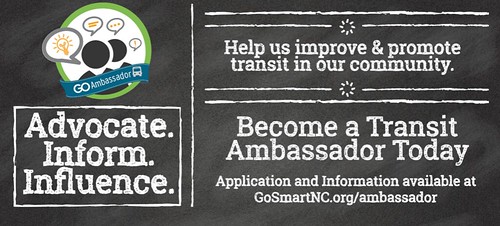
GoSmart is the brand for transportation demand management. The GoPass is the discounted/free transit pass offered to students and staff by universities and to employees by participating employers.. GoTogether is the marketing campaign promoting sustainable mobility and transit use, while GoAmbassador is the sub-brand for their transit volunteer program.
In short, transit service coordination and branding in the Raleigh-Durham region is a model example of best practice, demonstrating that multiple agencies can build and deliver better and seamless services to riders by working together.
Systems with multiple modes like in the DC area (train, subway, various forms of bus, streetcar; in Boston, ferry service and light rail too) might argue that it's easier to integrate in Raleigh-Durham because thus far, they only provide bus services.
But judging by how bus service in London is provided by multiple operators under the London Transport "brand," or how transport associations in Germany's metropolitan areas coordinate service delivery across multiple modes and communities, I don't think that operation of multiple modes is a significant barrier to service integration. Also see "One big idea: Getting MARC and Metrorail to integrate fares, stations, and marketing systems, using London Overground as an example."
Common transit infrastructure design. I doubt though, that the transit agencies in the Triangle area of North Carolina have settled on a single model for bus shelters and stations. That is an issue in the DC area too.
I have discussed elements of this in terms of transportation infrastructure as an element of civic architecture, making these points:
1. Transit infrastructure brands transit
2. Transit stops and stations are key marketing touchpoints
3. Transit stops and stations should better integrate within neighborhoods
4. Transit stops and stations should, when practical, interpret and present transportation-transit history
5. Transit vehicles can be an element of city/urban design and branding
6. Transit vehicles can be an element of transit marketing
Because DC is a large city by comparison, there is interest on the part of large advertising companies like Clear Channel (which has the contract), JCDecaux, Cemusa, and others to provide transit shelters in return for being able to place and sell advertising on the structures.
In 2005, DC signed a long term contract with Clear Channel, and the city has upgraded the shelters across the city. Meanwhile, the other jurisdictions, and WMATA have different standards, shelters, etc. Some are better than others.
DC's old bus shelters are comparable to the shelters still used today at Metrorail stations

Current DC bus shelter
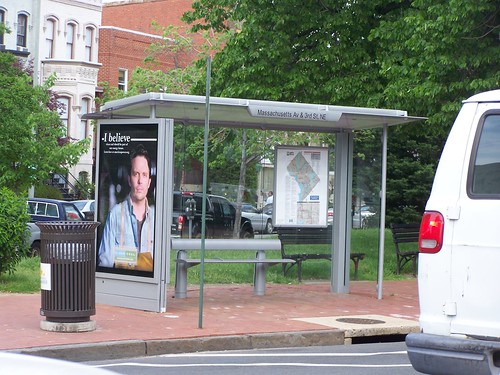
Montgomery County Maryland bus shelter, Wikipedia photo

It would be optimal to build a common transit shelter system at the metropolitan scale so that "surface transit" would read the same way across the metropolitan area, regardless of what city or county you're in. Much of the analysis in my recent review of the new Takoma Langley Crossroads Transit Center is relevant to this general point.
This also came up in Arlington, where citizens revolted against what they thought was an overly expensive program for new bus shelters ("Arlington County's bus shelters and a public realm framework of quality").
MBTA Silver Line bus station. Photo by Steve Pinkus. One problem I have with these shelters is that they are open to the elements, which is no fun in bad weather. The stations typically include kiosks with route maps and sometimes interpretation boards on cultural history.

Conclusion. Boston doesn't have the same issue of polyglot and discoordinated branding and services that is the case in DC which has a separate service for most of the separate jurisdictions.
By contrast, like in Baltimore, all of the transit services are provided by one agency, the MBTA. The problem is that bus service is a legacy service and in desperate need of a reboot--and its branding lags the train and subway services.
MBTA did that kind of reboot with their Silver Line bus rapid transit service ("Silver Line: 10 years of history, changes," Boston Globe, and "The Silver Line Expansion Is a Rare Bright Spot for the MBTA," Boston Magazine; Boston Silver Line Washington Street Bus Rapid Transit (BRT) Demonstration Project Evaluation, FTA), but those ideas haven't migrated to regular bus service.
That's the kind of quantum change that needs to be considered by most transit agencies.
The Raleigh-Durham model of coordination is one that is relevant to transit agencies and metropolitan areas whether or not they have one transit agency or several.
The learning is that riders hanker for a seamless service and that agencies can change and reposition legacy services to do this, if they are willing and committed to doing so.
Recommendations
1. If there are multiple agencies: coordinate and collaborate.
2. Develop and implement a common branding system.
3. Develop and implement a common system of transit infrastructure.
4. If it is a single (but legacy) system: rethink; reboot; reposition; rebrand
 Boston's newer transit stations incorporate some design thinking that is quite forward, but as a whole the system hasn't been rebranded. Image by the SubwayNut. The tagline reads: "America's first subway and the best way to get around Boston."
Boston's newer transit stations incorporate some design thinking that is quite forward, but as a whole the system hasn't been rebranded. Image by the SubwayNut. The tagline reads: "America's first subway and the best way to get around Boston."For other elements of a high quality surface bus network, see "Is making surface transit free the best transit investment DC can make?."
Labels: bus, bus rapid transit, bus stations, equity planning, provision of public services, public finance and spending, transit marketing, transportation equity, transportation planning




16 Comments:
Richmond:
http://www.richmond.com/news/article_83cb4090-ba02-5e48-833f-0cab075c6a49.html
http://www.richmond.com/news/article_77333ae8-e769-534a-a873-f85151877f38.html
City recommends refiguring bus service with a high frequency network in association with the launch of a BRT line. The transit agency says that's too much.
richmondtransitnetwork.com
likely this is deserving of a separate entry.
at a more granular level in DC, if you want to make buses cool:
1. Get rid of of the homeless people. Tired of urination and other bodily stuff on seats.
2. Rationalize the lines. There is a lot to unbundle there, but the majority of DC bus lines don't make sense -- and don't work for middle class commuters.
3. Fix the AC and suspensions.
Was in Cleveland, and got to see an actual working bus signal -- and clearly the one we have on 16th is not turned on yet.
The nextbus/GPS systems probably did the most to drive bus ridership.
Big tension between cool and equitable. The best way to be equitable is having functioning public services.
is it the suspensions?
I can't read on buses in the DC area, it upsets my stomach/eyes.
But I was able to read on MTA buses going up and down Greenmount Ave./York Road in Baltimore City/County.
2. Re: Big tension between cool and equitable. The best way to be equitable is having functioning public services.
yes, yes, yes, yes, yes, yes, yes, yes,
yes, yes, yes, yes, yes, yes, yes, yes,
yes, yes, yes, yes, yes, yes, yes, yes.
3. wrt rationalization, I'd argue the system is sort of rationalized, but not branded and operated as such.
You have the trunkline routes--X2, 70, S, 30, 50, 90.
Then you have lines that run through neighborhoods that typically run between Metrorail stations. Some are direct and some more meandering.
But the trunkline services aren't branded and marketed as trunkline services, what the more enlightened systems call "the hi/high frequency transit network".
I would probably re-articulate some of the neighborhood to be less meandering and complement that with the "intra-neighborhood" services I constantly hype.
Minneapolis Hifreq map
https://www.metrotransit.org/high-frequency-network-map
http://nmotion2015.com/wp-content/uploads/2015/08/nMotion-Frequent-Transit-Network-150710_FINAL.pdf
Minneapolis Metro Transit Call Center
https://www.minnpost.com/line/2017/01/smart-transportation-tools-how-metro-transit-uses-technology-ensure-smooth-ride
article about CityMapper, the integrated transit/mobility trip mapping app:
https://www.bloomberg.com/news/articles/2018-03-26/the-guy-making-public-transit-smarter
Syracuse to NYC and Philadelphia To DC you get cheap bus tickets and Lowest Price. No booking fees!
job. Keep it up. Transportation to Montebello Transportation to Montreal
Hi Admin, I hope are fine. I'm your one of the biggest fans, I like to read your blogs and I've also shared your blogs with my family members and friends. I hope in future you'll publish more blogs like your old ones. Please accept my thanks on my behalf of me and from my family and friends.
1947 Housing Islamabad
Capital Smart City
Lahore Smart City
New Metro City Gujar Khan
Skip Hire Near Me
You have touched some pleasant factors here.
Any way keep up wrinting. Feel free to visit my website;
It’s perfect time to make a few plans for the future and it is time to be happy.
I’ve read this post and if I may I want to suggest you some attention-grabbing things or suggestions.
its really really fastidious piece of writing on building up new weblog.
The ice that blooms is powerful. It is sending.
Please let me know where you got your design. Many thanks
A car parts warehouse is a facility or business that stocks and sells automotive parts and accessories. These warehouses typically serve as a centralized distribution center where a wide range of auto parts are stored before being shipped to retailers, repair shops, or directly to customers.
Post a Comment
<< Home